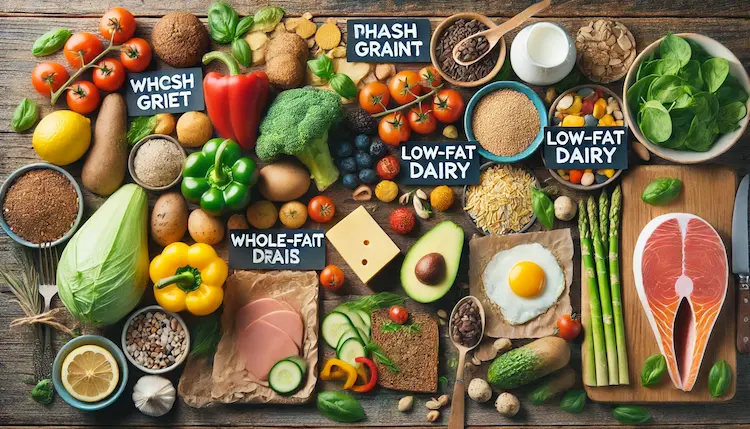The Dietary Approaches to Stop Hypertension (DASH) diet is a well-researched eating plan designed to prevent and manage high blood pressure. Developed through extensive clinical studies, it emphasizes nutrient-rich, whole foods that support cardiovascular health while offering broader benefits, such as weight management and reduced risk of chronic diseases.
What is the DASH Diet?
The DASH diet was created as a tool to combat hypertension (high blood pressure), a significant global health issue affecting over 1.28 billion people worldwide, according to the World Health Organization. By focusing on reducing sodium intake and emphasizing foods rich in potassium, magnesium, and calcium, the diet aims to naturally regulate blood pressure.
Key Components:
- Fruits and Vegetables: At least 4-5 servings per day
- Whole Grains: 6-8 servings per day
- Low-Fat Dairy Products: 2-3 servings daily
- Lean Proteins: Including fish, poultry, and plant-based options like beans
- Nuts and Seeds: 4-5 servings per week
- Limited Sodium Intake: Under 2,300 mg daily, or ideally 1,500 mg for optimal results
Importance and Benefits of the DASH Diet
1. Blood Pressure Management
Research shows that the DASH diet can lower systolic blood pressure by 8-14 mm Hg, offering an alternative or supplement to medication.
2. Weight Loss
Although not explicitly designed for weight loss, the DASH diet’s emphasis on whole foods and reduced processed items naturally supports calorie control.
3. Heart Disease Prevention
High blood pressure is a significant risk factor for heart disease. By lowering blood pressure, the DASH diet helps reduce the risk of heart attacks and strokes.
4. Diabetes Management
With its low-glycemic foods, the DASH diet is effective in stabilizing blood sugar levels, making it beneficial for those with type 2 diabetes.
5. Improved Overall Health
A nutrient-dense eating plan supports brain health, lowers inflammation, and reduces the risk of certain cancers.
DASH Diet vs. Other Diets
| Feature | DASH Diet | Mediterranean Diet | Keto Diet |
|---|---|---|---|
| Primary Goal | Lower blood pressure | Heart health and longevity | Weight loss |
| Focus Foods | Fruits, vegetables, whole grains | Olive oil, fish, nuts | High-fat, low-carb |
| Sodium Limit | Yes, under 2,300 mg | Moderate | No focus on sodium |
| Flexibility | High | High | Low |
| Sustainability | Excellent | Excellent | Moderate to low |
Practical Steps to Follow the DASH Diet
- Plan Your Meals
Incorporate fruits and vegetables into every meal. A sample breakfast could include oatmeal topped with berries and a glass of low-fat milk. - Limit Sodium Gradually
Start by reducing salt in cooking and choosing low-sodium packaged foods. Use herbs and spices for flavor. - Choose Whole Grains
Replace refined grains with whole-grain options like quinoa, brown rice, or whole-grain bread. - Opt for Lean Proteins
Include skinless poultry, fish, or plant-based proteins like beans and tofu. - Snack Smart
Opt for nuts, seeds, or fresh fruit instead of processed snacks.
Tips for Success
- Meal Prep: Prepare meals in advance to avoid unhealthy choices during busy days.
- Track Your Sodium: Use a food diary or app to monitor sodium intake.
- Stay Hydrated: Drink water throughout the day to stay hydrated and reduce cravings.
- Seek Support: Join online forums or groups focused on the DASH diet for motivation and recipe sharing.
Visualizing the DASH Diet
Here’s how the DASH diet’s recommended servings translate into a typical day:
| Food Group | Servings | Example Foods |
|---|---|---|
| Fruits | 4-5 | Apples, bananas, berries |
| Vegetables | 4-5 | Spinach, carrots, broccoli |
| Whole Grains | 6-8 | Brown rice, whole-grain pasta |
| Dairy | 2-3 | Low-fat yogurt, skim milk |
| Proteins | 2 or less | Grilled chicken, beans |
| Nuts/Seeds | 4-5 (weekly) | Almonds, sunflower seeds |
Summary and Key Takeaways
The DASH diet is more than just a tool for managing high blood pressure—it’s a blueprint for a healthier lifestyle. By emphasizing nutrient-rich foods and minimizing sodium, it promotes long-term health benefits, from heart disease prevention to weight management. To succeed with the DASH diet:
- Incorporate a variety of fruits, vegetables, and whole grains.
- Monitor sodium intake diligently.
- Focus on consistency rather than perfection.



